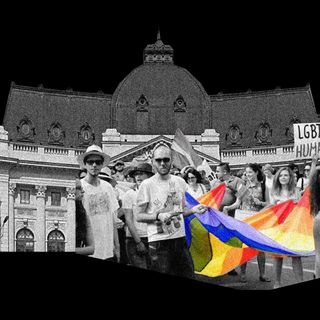One of the biggest myths surrounding bisexuality is the distinction between bi-curiosity and bisexuality, with the former perceived, at best, as somewhat of a gateway to the latter, and at worst, as bisexual-lite, or simply posturing. Bi-curiosity is painted as a desire or curiosity toward a certain type of sexual orientation; bisexuality the ‘actual’ or ‘real’ deal.
This is just one example of the myriad ways in which people who are Questioning — one of the ways the ‘Q’ in LGBTQIA+ is defined — of their sexual orientation or gender identity are treated as separate from mainstream queer circles. The Questioning aspect of their identity is often pushed to arrive at a clear-cut answer regarding their queerness, and where it lies within the LGBT lexicon, or go back to cisgender heterosexual camp as if having failed the test. This gatekeeping from LGBTQIA+ circles not only restricts people’s access to the kind of queer-affirming resources and support such spaces can provide, it also limits collective societal understanding of queerness.
People at the margins of queer advocacy have been trying to normalize sexuality and gender as fluid concepts, which don’t have to adhere to strict definitions of L, G, B or T in order to be considered queer. They’re trying to normalize existing in a state of flux — much like people who are Questioning of their sexual and/or gender identity — as a normal experience, and possibly as the foundation of how we understand, accept and normalize all queer experiences in the future.
Looking at the microcosm of bisexuality, however, it feels that we’re a long way away from manifesting such an evolved understanding of sexual and/or gender identity. We see an exclusionary narrative play out, which often reduces questioning people to dabblers from the queer side, and an easily fetishizable commodity minus the baggage of identity from the heterosexual side.
Related on The Swaddle:
Asexuality Is a Sexual Orientation, Not a Disorder
Bi-curiosity is often reserved for the trope of the wild college girl who experimented with other women back in school, but has since straightened out, so to speak. In pop culture, the woman exploring her sexuality is either glamorized (think: Rachel in F.R.I.E.N.D.S) for having conformed to the male fantasy of being sexually adventurous in her youth, or chided for having treated it as an experiment or rite of passage. In both of these instances, however, the woman’s actions are being judged against a backdrop of the mainstream understanding of queerness — she ‘experiments’ only a few times, so it doesn’t make her an actual bisexual woman, but she does it enough that heteronormative narratives paint her as ‘wild’ and deviant. Either way, there manifests an implication that the woman would have to pass a pre-determined test to convince people of her queerness, which often mandates demonstrated, and continued sexual experience.
Understanding why we make this distinction between bi-curiosity and bisexuality provides a window into how we often treat people curious or unsure of their sexual and/or gender identity. On the one hand, they suffer gatekeeping from LGBTQIA+ circles, who fear their lives are simply being fetishized by heterosexual people wanting to prove their ‘wildness.’ On the other hand, people who are questioning actually do get fetishized by straight, cisgender people, as often seen in the way young queer women questioning their sexuality are portrayed in television and movies. This can also lead people to internalize such narratives — is a person queer when they’re living out their sexual or gender identity? Is a person queer when they can finally define themselves as L, G, B, or T? Or is a person queer when they’re simply questioning heteronormative ideas of love, attraction, and gender?
By keeping the latter out of everyday conversations, we not only restrict our collective understanding of different LGBTQIA+ lived realities, but also ensure Questioning people live their lives out on the margins, never fully welcomed into mainstream queer circles, and feeling like they don’t fit in the heteronormative mold either.
The goal here isn’t to be able to identify as L, G, B, T at the end of the long tunnel that facilitates the exploration of a person’s sexual and/or gender identity. It’s to normalize this process of exploration, which can exist in a state of flux for entire lifetimes. ‘Q,’ for example, is also defined as Queer, which is adapted by people not living out exclusively heterosexual or cisgender realities. What it actually means is often left up to the individuals to determine as and when they want.
In order for queer experiences to not be deemed as deviant from heterosexual, cisgender realities, it’s essential all queer realities are incorporated into LGBTQIA+, with a focus on normalizing Questioning/Queer as one of the most common ways in which people grapple with their sexuality and gender. The ‘Q’ is not only not deviant from queerness, but it’s also the key to denormalizing heteronormativity.




